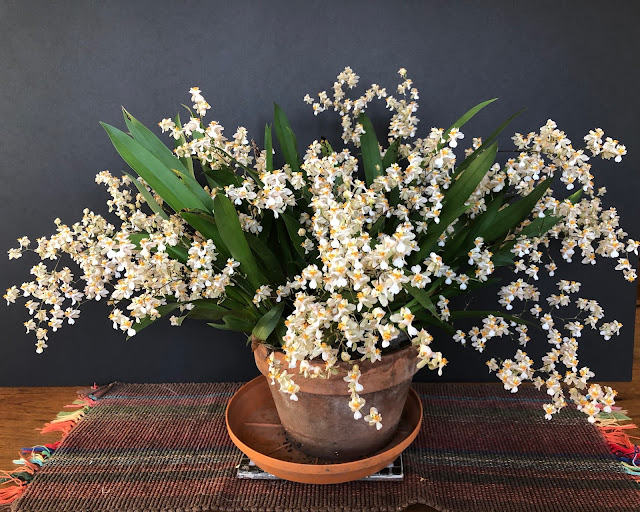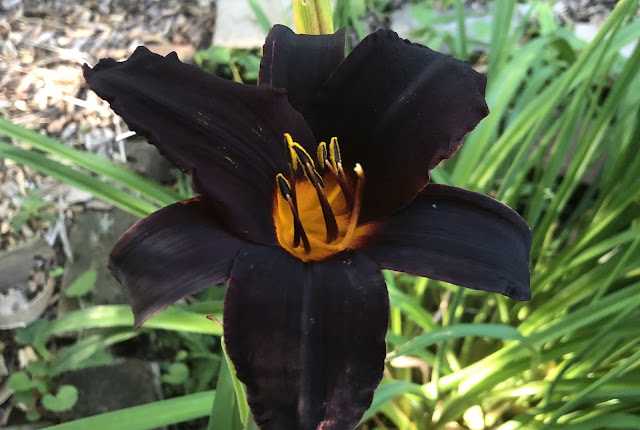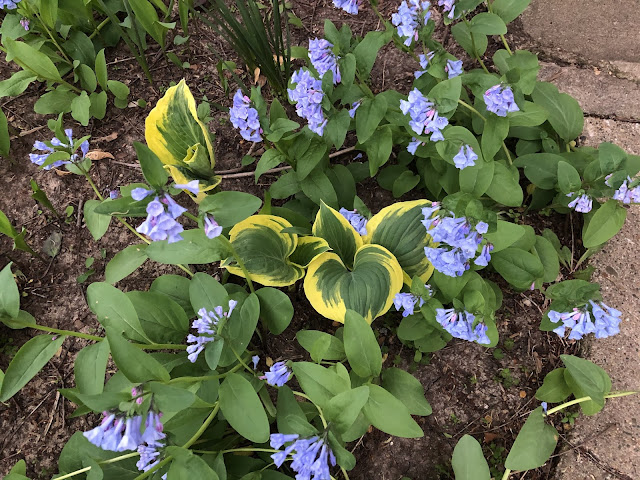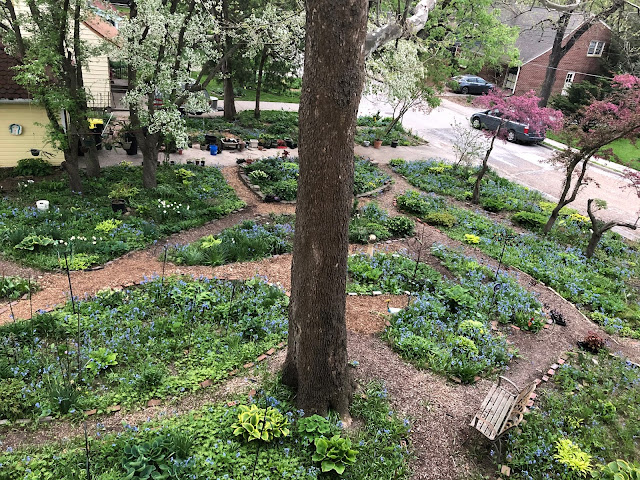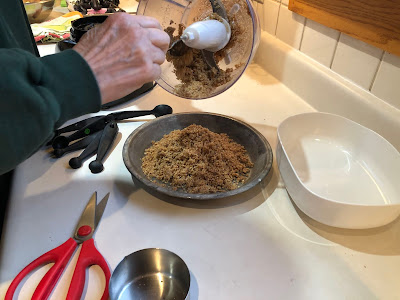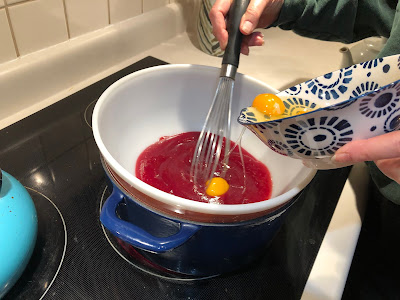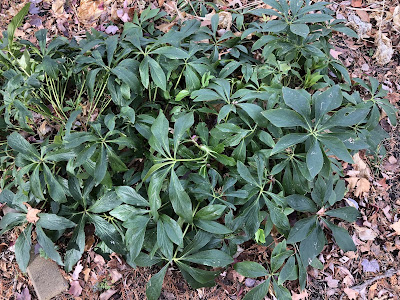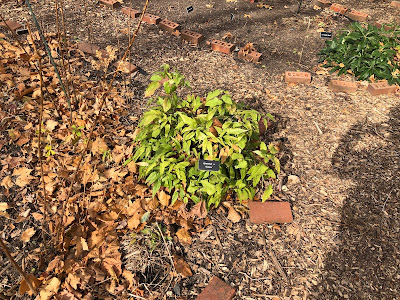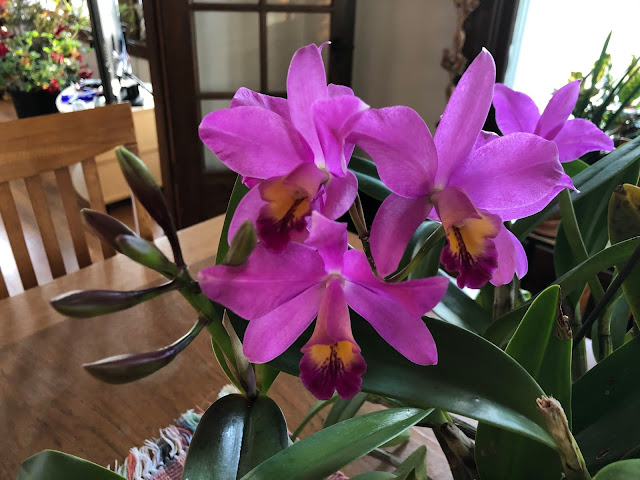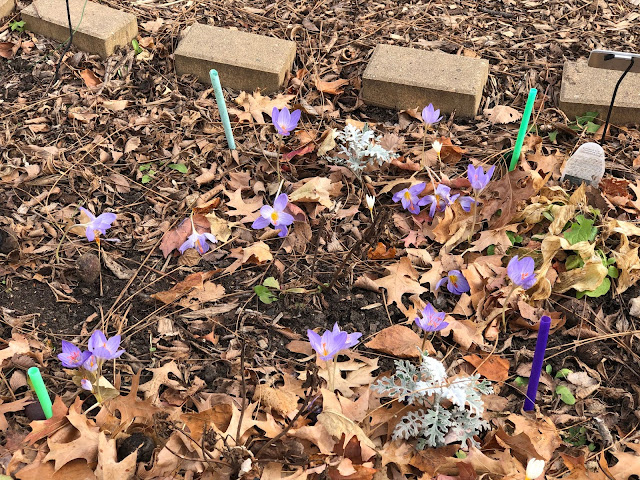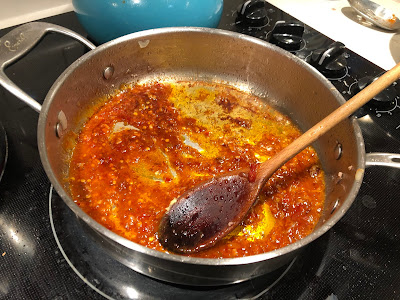Welcome to the Mears Garden Winter picture contest, a yearly feature of the Mears Garden blog since 2006. It is one small way to get through the winter.
Each week for the next 13 weeks I will give you 5 picture contestants from the 2020 Mears garden (mostly outdoor; occasionally indoor). You get to vote for the one you like best. There is voting in a poll that is on the right. (If you are viewing this on your phone you will have to go to the bottom and select "view web version".) Voting takes place throughout the week.
At the end of 13 weeks there will be playoffs featuring the weekly winners and a few wildcards.
Also each week there are bonus pictures, sometimes related to the particular contestants.
Julia adds a recipe each week, something she has done since 2016, when she began providing recipes to maintain our sanity. All of her recipes can be found on their own separate blog, organized by our daughter Katie.
https://mearskitchen.wordpress.com/
For those of you new to the blog there is an archive of blog posts at the right, which goes back to July 2007. There you can review all of the contests since that date. What else is there to do in the winter?
Along the way we talk gardens and flowers and sometimes whatever comes to mind. I particularly appreciate hearing from you, beyond your vote. You can do that with the "comments" section at the bottom of each post. With many readers I send you a weekly email, announcing the post. Some people choose to respond by email. If you wish to receive that email, let me know at philip.mears@gmail.com.
Let me say a few more things about what you will find in the weekly blog.
In addition to the picture contestants I have a 'bonus section.' In that section I add pictures and commentary, mostly related to the different contestants.
I sometimes have a section called 'right now'. In that section I talk about what is happening in the garden 'right now.'
Finally there is the closing section called 'Odds and ends.' That is where I add anything that does not fit elsewhere.
With that introduction, here are the first contestants.
Week #1
#1 Oncidium Orchid
(January 1. 2020)
In a contest with pictures from garden year 2020, I figured I would start with a picture from January 1. The orchid is an Oncidium. The name is probably Twinkle White.
Orchids are a real part of the garden. They spend the summer outside. If you have a shade garden, orchids are a natural. Some even bloom while outside. What is particularly nice is that just when the outside garden has shut down, along come the orchids.
I do not have a greenhouse. You do not need one to grow orchids. I have several light stands, some more professional than others. The orchids probably do better with this artificial light. (With many orchids a bright window is sufficient.)
The orchids and many other plants use these lights during the winter. I call it "winter," but it is really the "inside season." In Iowa this lasts from the middle of October until early May. Gosh that seems like a long time. I have maybe 30 orchids. Maybe about a dozen are what I refer to as old reliable orchids. This Oncidium is one of those. These reliables do well in the conditions I can provide. They rebloom every year. This one blooms around Christmas.
With this plant the tiny blooms appear on stems that are called "spikes." The spikes on this plant start during the summer.
In the bonus section of this post there is a picture of this plant from December 20, 2014. You can see how it has grown.
#2 Hosta Liberty with bluebells
(April 30, 2020)
At this time of the year when the garden has mostly turned brown, this picture warms my spirit. Hosta are a major feature in the garden. If you only had to have one hosta, I would recommend Liberty. It grows to a good size, and has such wonderful color. It grows rather quickly and holds up well to the elements.
And then there are bluebells. The bonus section will give you a feel for what they are like. Bluebells appear in early April. For a month they dominate the garden. I do not remember ever buying bluebells. Some of them must have been here when we moved in almost 40 years ago. (38 years to be exact.) But there was not much of a garden then. Bluebells spread over time.
What can I tell you about bluebells.
Bluebells last about a month. Then they die back until the next year.
They grow from tubers, that look a little like a small carrot.
The bulbs are deep enough that you can plant annuals right over top of them when they have finished.
They start out with a little bit of pink.
You can dig them up right when they emerge in the spring. You can then move them someplace else in the garden. They will also pot up rather easily, such as for an early spring plant sale.
They grow to about 12-15 inches tall. I do have to move any plants that are too close to other short plants. Liberty is an ideal size to coexist with the bluebells.
#3 Red Iceland Poppy
(May 27, 2020)
I have grown Iceland poppies for a quite a few years. I grow them from seed. Mostly they are annuals. I say that because they sometimes are listed as a tender perennial. I had 2 survive this past winter. Why those? Who knows.
The flowers are some of the best in the garden. This red one has appeared before in contests. It will be no big surprise but there will be more Iceland poppies in the contest over the next 3 months.
I thought I would lead with this wonderful red.
What is your favorite color in a flower? This bright red is certainly one of mine.
I try to plant the seeds in the first week of January.
That means that it actually is time to get the seed. Buying seeds does give you an appreciation of the past turning into the future.
These annual poppies do want sun.
I find they bloom in May but really will not last the summer. Too bad.
UPDATE: I obtained my Iceland poppy seeds Friday. I will start them right around January 1. That is really not that far away.
#4 Black daylily
(July 11, 2020)
Daylilies carry the garden from late June to August. One favorite is this really black daylily. The black is particularly good with that yellow center.
The era of daylily enthusiasm in the garden was 1995-2005. I kept track not only of names and dates planted, but even the number of "scapes." Scapes are the long stems on which the group of daylilies grow. A scape might have anywhere from 4-10 flowers.
Daylilies do require a decent amount of sun. That is at a premium in our garden as we have many mature trees. "High shade" is the term.
#5 Tri color crocus
(March 17, 2020)
I long for spring bulbs to appear. Sometimes they actually show up as early as February. The first two bulbs that emerge are snowdrops and aconite. They are white and yellow. The flowers/bulbs with the first real color would be the crocuses.
This little beauty is actually named "tricolor." This bloomed in 2020 on March 17. The first recorded crocus in 2020 was on March 3. That is not so far away.
There you have the 5 contestants for this first week. Sometimes if the contestants include a "ringer," I can predict the winner for the week. I challenge you to not only think about which picture you like the most, but to also consider which picture you think will get the most votes.
But seriously I really like to hear back from each of you. I not only want you vote, but also some of your thoughts. Consider either commenting or replying to the emails I send out. If you do not get those emails, and wish to, let me know and I will add you to the email list. My email address is philip.mears@gmail.com.
I think you can also subscribe to the blog by entering your email address near the top of the blog on the right.
Bonus section
Each week I add extra pictures, often related to the contestants.
Here for example is the Oncidium from December, 2014.
This is a closeup of the tiny flowers.
The plant did get to be the center piece for our dining room table.
Here is this year's centerpiece for Thanksgiving.
Here was the first crocus of 2020. It bloomed on March 3. I do not think it is coincidental that it was white, the color of snowdrops. You wonder if brighter colors would attract critters that would eat it.
I do understand that snowdrops and aconite do not taste good. That makes so much sense. The good tasting early bulbs were naturally unselected rather early on.
Here are more bluebell pictures.
I cannot wait until the bluebells appear again.
Here is a cropped picture of the center of the black daylily.
Right Now in the garden
In this part of the blog I talk about what is going on in the garden (as extended into the house),
I still have a few herbs, grown this summer in our rented sunny garden plot. It was nice to be part of a community garden. You got to see what other people were growing. You could watch as their tomatoes also got away from them.
Pansies grow in the fall, not really caring about frosts. It will have to get down to maybe 10 to end their blooming runs.
They also mostly survive the winters. They might be perennials if it were not for the heat of the summer.
I planted many fall crocuses in September. They have lived up to expectations.

Hellebores can sometimes set buds late in the fall. This does not happen often. Sometimes it has even bloomed at Thanksgiving. One plant is close this year. This picture was taken yesterday as the temperature got into the mid 50's.
It is to get cold in the next few days. It could get to 15 at night. That might be a challenge for these buds. Maybe I will do a controlled experiment. I will leave one on the plant and bring the other inside. I think the bud is mature enough that it will bloom if I bring it in. I will let you know.
Julia's recipe
Cranberry lime pie
Every once in a while a food enthusiasm arises at Thanksgiving. I remember some years ago it was brussels sprouts. I was shopping at the Co-op during the few days before Thanksgiving, with a bag of sprouts in my cart, when the produce manager stopped me to ask why was there a run on brussels sprouts? I answered that roasting with olive oil and kosher salt was now a thing. Which it was and we have served them ever since.
This year it seems to be cranberry pie. There are recipes in Cook's Illustrated, the NYTimes, and Parade magazine (the weekend newspaper insert). And also in the Iowa City Press-Citizen, where the recipe is credited to the epicurious website. I made the one from the IC P-C, with a few simplifications. The pie was not too sweet (because of the lime) and different. The crumb crust was crisp and flavorful.
Here are the ingredients.
First the crust: 4 oz. of store-bought gingersnaps (I used Pepperidge Farm which had the advantage of tasting really good, as there are leftover cookies); 1 cup of pecans (pieces are fine); 3 tablespoons of brown sugar; and 4 tablespoons of melted butter.
The filling: 1 can of jellied cranberry sauce (not whole berries); 2 whole eggs and 2 egg yolks; 1 teaspoon of lime zest; 1 teaspoon of lemon zest; 1/2 cup of lime juice and 8 tablespoons of butter.
I forgot to cut one of the sticks of butter in half before the picture. You will need a total of 1-1/2 sticks of butter for the entire operation.
I started by melting 4 tablespoons of the butter over low heat. While that was going on, I put the rest of the piecrust ingredients into the food processor. 4 oz. of gingersnap cookies turned out to be 6 or 7. Figuring out how many cookies you will need will be a math exercise: net weight of the contents of the box divided by number of cookies will give you weight per cookie; then multiply to figure out how many cookies gets you to 4 oz. I recently bought a small non-battery-powered kitchen scale. No math for me.
I zizzed up the cookies and pecans and brown sugar until they were finely ground and then drizzled in the melted butter.
I turned the oven on to 350 degrees.
And I cracked the eggs, separated the 2 yolks I needed (saving the whites for another use) and cut up the stick of butter into little pieces - all for later.
I dumped the contents of the food processor into a 9" pie pan, and I used a measuring cup to tamp down the crumbs and mash them up the sides of the pie pan.
I baked the crust in a 350 degree for about 10 minutes until the crust looked set and the upper edges looked a little bit browned.
I let it cool on the counter as I turned my attention to the filling.
This is where I parted company with the newspaper recipe, which wanted me to make cranberry sauce from fresh cranberries with a reduced amount of water and the usual sugar and then zizz them in the food processor and then strain them through a sieve. Too much work.
I bought a can of jellied cranberry sauce. I zizzed it in the food processor (because, true to form, it came out of the can in a perfect cylinder). I did not wash or rinse out the food processor. A few crumbs of the crust did not matter at all. Next, I constructed a double boiler by putting a bowl into a pot with about an inch of water in the bottom. The idea is to have the bowl above the water level. I turned the heat on to low-medium. I poured/scraped the cranberry puree into the bowl, set the bowl over the water and whisked the eggs (and egg yolks) in one at a time.
Then I whisked in the lime zest and the lemon zest and the lime juice.
On further reflection, I think 1/3 cup of lime juice would do it. The pie was a bit tart which was fine, but I think it would work well with a bit less lime juice. The zests are good as specified.
Here's the thing - cranberries are so tart that they require a fair amount of sugar to be palatable. But that makes for a somewhat one dimensional flavor. So the sweetness needs to be cut by something more bracing. This is why we like cranberry orange relish better than straight-up cranberry sauce. And why we like rhubarb pie to include a generous amount (say 1-1/2 teaspoons) of orange zest.
Back to the pie.
I cooked and stirred the cranberry/egg/citrus mixture in the double boiler for maybe 8 minutes. It actually thickened a bit by the end of that time.
Then I carefully (using potholders) lifted the bowl out of the pot of hot water and put it on a trivet.
While I was thinking about it, I put the pie crust into the refrigerator at that point to make sure it would cool more or less completely.
I plopped in the butter pieces, a few bits at a time, whisking in the bits before adding more. There was enough retained heat in the mixture to melt all the butter, although the amount of time it took to whisk the bits in lengthened as I went along.
I poured the filling into the pie crust, covered the top with a piece of saran wrap and put it in the refrigerator for a couple of hours.
Here it is out of the refrigerator.
And here it is on the plate with whipped cream.
The gingerbread-pecan-brown sugar and butter crust was very good. I think that using a store-bought cookie crust or graham cracker crust would be just fine.
The pie held up well - as custard pies do. It tided us over until Thanksgiving when more pies appeared on the menu. Pie is festive, especially with whipped cream.
Odds and Ends
Friday I bought some Iceland poppy seed along with some Shirley poppies. I will start them right after the first of the year. Several Iceland poppies actually made it through the summer and still show some green. I will be interested in seeing if they make it through the winter.
I grow a tropical plant called a croton. That is one of my enthusiasms at the moment. I have about 10 varieties. Some are still small. Some are 4 foot tall. Many live in the living room for the winter. When they come inside often they experience leaf drop. But I have been there often enough to know they will put out new growth. That is happening now.
Particularly over the winter I grow some plants from cuttings. I do that in the outdoor season with annuals, such as impatiens. Over the winter I try to start more crotons and this year, a few hoyas. Here is one little croton. It took almost a month to start growing roots. I can move it to dirt when the roots are a little bigger.
Hoyas are good. Hoya enthusiasm is right around the corner for me.
It was 50 degrees yesterday, as a high temperature. It will be 30 degrees tomorrow, as a high. It seems like that happens every Thanksgiving. The warm weather lasted for a long time. But it had to end. I can remember years when the drop off would include snow.
It really must be time for the cold season. We went for a walk yesterday, on a path just south of the Coralville dam. We counted eagles. They are back.
We counted 8. Two are in this picture. Look for tiny bits of white high up in the trees - eagle's heads.
That is it for this week.
I hope you have enjoyed this first week of the contest. I do appreciate hearing from you.
Be safe. We know better times are coming. We just have to make it a little bit longer.
Philip
